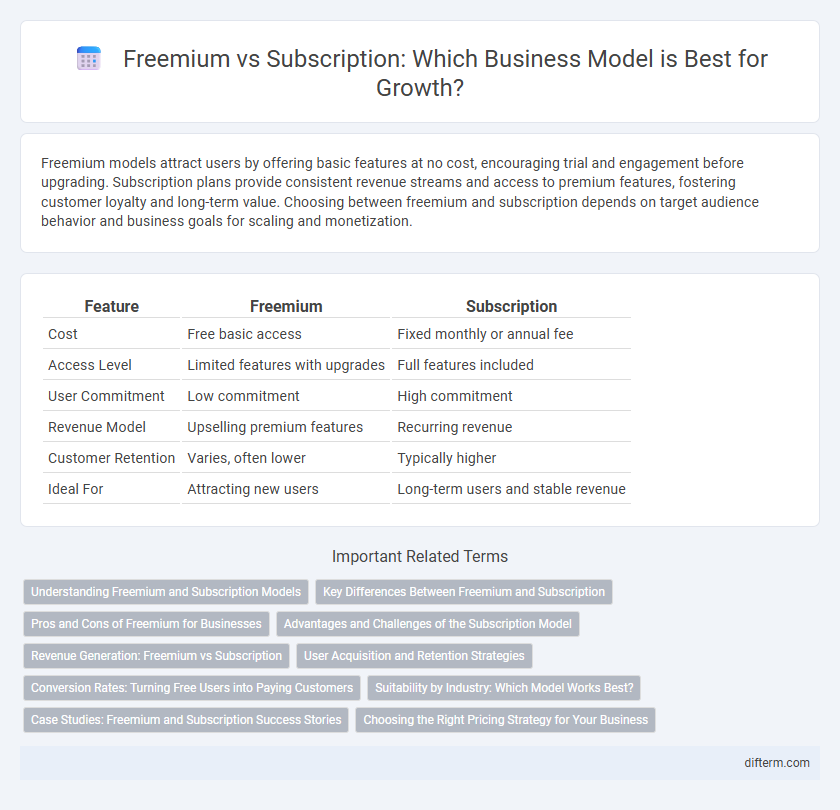Freemium models attract users by offering basic features at no cost, encouraging trial and engagement before upgrading. Subscription plans provide consistent revenue streams and access to premium features, fostering customer loyalty and long-term value. Choosing between freemium and subscription depends on target audience behavior and business goals for scaling and monetization.
Table of Comparison
| Feature | Freemium | Subscription |
|---|---|---|
| Cost | Free basic access | Fixed monthly or annual fee |
| Access Level | Limited features with upgrades | Full features included |
| User Commitment | Low commitment | High commitment |
| Revenue Model | Upselling premium features | Recurring revenue |
| Customer Retention | Varies, often lower | Typically higher |
| Ideal For | Attracting new users | Long-term users and stable revenue |
Understanding Freemium and Subscription Models
Freemium and subscription models offer distinct approaches to revenue generation in business, with freemium providing basic services for free while charging for premium features, and subscription requiring regular payments for continuous access. Freemium aims to build a large user base quickly by lowering the entry barrier, frequently relying on upselling or advertisements for monetization. Subscription models focus on consistent, predictable revenue by offering exclusive content or services to paying customers, enhancing customer retention through ongoing value delivery.
Key Differences Between Freemium and Subscription
Freemium models offer basic services at no cost while charging for premium features, targeting user acquisition and engagement without upfront payment barriers. Subscription models require customers to pay a recurring fee for continuous access to all features, emphasizing predictable revenue and customer retention. Key differences include payment structure, customer commitment, and revenue predictability, with freemium relying on upselling free users and subscriptions ensuring steady income from paying members.
Pros and Cons of Freemium for Businesses
Freemium models attract a large user base by offering core features for free, lowering the entry barrier and increasing brand exposure. However, converting free users to paid subscribers can be challenging, often requiring significant investment in premium feature development and marketing. Businesses risk high churn rates and potential undervaluation of their product if the free tier delivers too much value without adequate incentives to upgrade.
Advantages and Challenges of the Subscription Model
The subscription model offers predictable revenue streams and enhances customer retention by fostering long-term relationships through continuous service delivery. It enables businesses to gather valuable user data, facilitating personalized experiences and targeted marketing strategies that drive growth. Challenges include managing customer churn, ensuring consistent value to prevent cancellations, and handling the complexities of recurring billing and subscription management systems.
Revenue Generation: Freemium vs Subscription
Freemium models generate initial user acquisition through free access but rely heavily on a small percentage of users converting to paid plans for revenue growth. Subscription models provide predictable and steady revenue streams by charging customers a recurring fee, enhancing long-term financial stability. Businesses leveraging subscriptions often achieve higher customer lifetime value compared to freemium approaches, which can incur high support and infrastructure costs without guaranteed conversion rates.
User Acquisition and Retention Strategies
Freemium models accelerate user acquisition by offering core features for free, lowering the barrier to entry and attracting a broad audience quickly. Subscription models drive higher retention rates through consistent value delivery and exclusive content, fostering long-term customer loyalty and predictable revenue streams. Optimizing the balance between freemium user onboarding and subscription-based engagement maximizes customer lifetime value and sustainable growth.
Conversion Rates: Turning Free Users into Paying Customers
Freemium models typically experience a conversion rate from free users to paying customers ranging between 1% and 5%, depending on product complexity and value perception. Subscription models often achieve higher conversion rates, averaging around 10% to 20%, due to clearer pricing and committed user intent. Optimizing onboarding and personalized engagement strategies significantly enhances conversion efficiency within both freemium and subscription frameworks.
Suitability by Industry: Which Model Works Best?
Freemium models excel in technology and software industries where user acquisition and product trial drive growth, especially for apps and SaaS platforms targeting mass markets. Subscription models offer greater predictability and revenue stability, making them ideal for media, entertainment, and professional services where ongoing content delivery or expert access is crucial. Businesses in sectors like healthcare and finance often prefer subscriptions due to compliance requirements and the need for continuous service updates.
Case Studies: Freemium and Subscription Success Stories
Case studies reveal that companies like Spotify and Dropbox leveraged the freemium model to rapidly grow their user base by offering essential features for free while converting a percentage of users to premium subscriptions. Subscription-based services such as Netflix demonstrate sustained revenue growth through consistent monthly billing and high customer retention by continuously expanding content offerings. Data shows that combining freemium adoption incentives with subscription upgrades can optimize lifetime customer value and reduce churn rates in competitive markets.
Choosing the Right Pricing Strategy for Your Business
Selecting the ideal pricing strategy requires analyzing customer behavior, revenue goals, and market positioning. Freemium models attract a broad user base by offering essential features for free while converting a percentage into paying customers through premium upgrades. Subscription pricing ensures recurring revenue and fosters customer loyalty by providing ongoing value through regular updates and exclusive content.
freemium vs subscription Infographic

 difterm.com
difterm.com